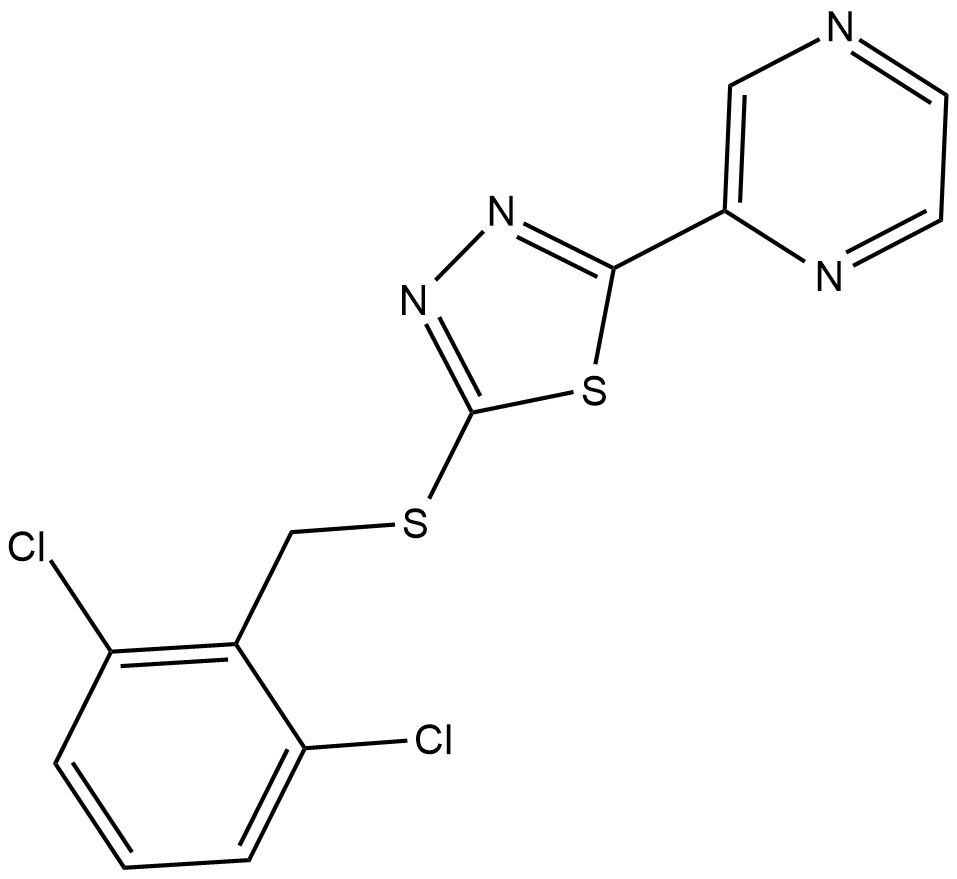Yoda1 |
| Catalog No.GC18233 |
Yoda1 is an agonist for both human and mouse Piezo1.
Products are for research use only. Not for human use. We do not sell to patients.

Cas No.: 448947-81-7
Sample solution is provided at 25 µL, 10mM.
Yoda1 is an agonist for both human and mouse Piezo1. Yoda 1 activates purified Piezo1 channels。The EC50 of mouse was 17.1 µm, and that of human was 26.6 µm[1].Yoda1 has been widely used to study the gating mechanism of Piezo and various PIEzO-related biological processes[5].
Yoda1 induces activation of both Akt and ERK1/2 in endothelial cells (ECs), which is not dependent on Piezo1[2].Yoda1 induced the activation of Akt and ERK1/2, and the increase of their respective phosphorylation levels reflected that the phosphorylation of the two signaling molecules also increased with the increase of Yoda1 concentration[4].Activation of Piezo1 by Yoda1, a Piezo1 agonist, caused calcium influx and profibrotic responses in HK2 cells and induced calcium-dependent protease calpain2 activation, followed by adhesion complex protein talin1 cleavage and upregulation of integrin β1. Also, Yoda1 promoted the link between ECM and integrin β1[7].Yoda1 Enhanced Low-Magnitude High-Frequency Vibration on Osteocytes in Regulation of MDA-MB-231 Breast Cancer Cell Migration[8].
Agonist Yoda1 effectively inhibited calcium influx caused by hypertension. Antithrombotic studies proved that the inhibition of Piezo1 effectively inhibited arterial thrombosis and reduced the infarct size of stroke in hypertensive mice[6].A Yoda1-like exercise pill has the ability to specifically target and enhance Piezo1 activity during exercise[3].
References:
[1]: Syeda R, Xu J, et,al. Chemical activation of the mechanotransduction channel Piezo1. Elife. 2015 May 22;4:e07369. doi: 10.7554/eLife.07369. PMID: 26001275; PMCID: PMC4456433.
[2]:Dela Paz NG, Frangos JA. Yoda1-induced phosphorylation of Akt and ERK1/2 does not require Piezo1 activation. Biochem Biophys Res Commun. 2018 Feb 26;497(1):220-225. doi: 10.1016/j.bbrc.2018.02.058. Epub 2018 Feb 8. PMID: 29428723; PMCID: PMC5835220.
[3]:Beech DJ. Endothelial Piezo1 channels as sensors of exercise. J Physiol. 2018 Mar 15;596(6):979-984. doi: 10.1113/JP274396. Epub 2018 Jan 9. PMID: 29194632; PMCID: PMC5851887.
[4]: Kuriyama M, Hirose H, et,al. Piezo1 activation using Yoda1 inhibits macropinocytosis in A431 human epidermoid carcinoma cells. Sci Rep. 2022 Apr 15;12(1):6322. doi: 10.1038/s41598-022-10153-8. Erratum in: Sci Rep. 2022 May 12;12(1):7873. PMID: 35428847; PMCID: PMC9012786.
[5]: Douguet D, Patel A, et,al. Piezo Ion Channels in Cardiovascular Mechanobiology. Trends Pharmacol Sci. 2019 Dec;40(12):956-970. doi: 10.1016/j.tips.2019.10.002. Epub 2019 Nov 5. PMID: 31704174.
[6]: Zhao W, Wei Z, et,al.Piezo1 initiates platelet hyperreactivity and accelerates thrombosis in hypertension. J Thromb Haemost. 2021 Dec;19(12):3113-3125. doi: 10.1111/jth.15504. Epub 2021 Oct 8. PMID: 34411418.
[7]: Zhao X, Kong Y, et,al. Mechanosensitive Piezo1 channels mediate renal fibrosis. JCI Insight. 2022 Apr 8;7(7):e152330. doi: 10.1172/jci.insight.152330. PMID: 35230979; PMCID: PMC9057604.
[8]: Lin CY, Song X, et,al. Yoda1 Enhanced Low-Magnitude High-Frequency Vibration on Osteocytes in Regulation of MDA-MB-231 Breast Cancer Cell Migration. Cancers (Basel). 2022 Jul 13;14(14):3395. doi: 10.3390/cancers14143395. PMID: 35884459; PMCID: PMC9324638.
Average Rating: 5 (Based on Reviews and 16 reference(s) in Google Scholar.)
GLPBIO products are for RESEARCH USE ONLY. Please make sure your review or question is research based.
Required fields are marked with *




